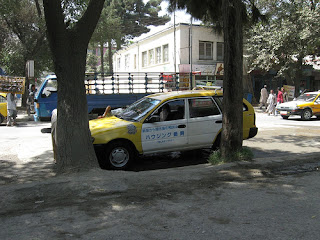Go Lewis!

 CKY
CKY
 The other Corolla ad I could have posted starred Peter Falk (as Columbo)
The other Corolla ad I could have posted starred Peter Falk (as Columbo) Suburb of Kabul or Yokohama?
Suburb of Kabul or Yokohama? In this consumerist and disposable world, it's good to see perfectly fine cars being used to its maximum (and beyond) potential. These Corollas are used by hard working entrepreneurs ad infinitum.
In this consumerist and disposable world, it's good to see perfectly fine cars being used to its maximum (and beyond) potential. These Corollas are used by hard working entrepreneurs ad infinitum. I must say, though, it was extremely difficult to find any decent photographs of the ubiquitous Kabuli Corolla taxi on the net. Their importance is taken for granted. They merely blend into the bleak and dusty background. But if anything will raise the phoenix from the ashes that is the Afghan capital, it is the peppy Corolla. Fight on!
I must say, though, it was extremely difficult to find any decent photographs of the ubiquitous Kabuli Corolla taxi on the net. Their importance is taken for granted. They merely blend into the bleak and dusty background. But if anything will raise the phoenix from the ashes that is the Afghan capital, it is the peppy Corolla. Fight on! CKY
CKY I can't believe that William F. Buckley and I have the same taste in movies, but we both think The Lives of Others is one of the best movies ever made. Ulrich Muhe's performance was extraordinary. It was like watching a German version of Kevin Spacey, but without the ego, the snarky facial expressions, or the multi-million dollar salary. The story, the message, and the ending blew me away.
I can't believe that William F. Buckley and I have the same taste in movies, but we both think The Lives of Others is one of the best movies ever made. Ulrich Muhe's performance was extraordinary. It was like watching a German version of Kevin Spacey, but without the ego, the snarky facial expressions, or the multi-million dollar salary. The story, the message, and the ending blew me away.



 In the 1970s, virtually every sporty Japanese car in the Japanese market had fender mounted side mirrors. Though they look odd to the contemporary round eye, hundreds of millions of people grew up accepting the fender as the default location of side mirrors.
In the 1970s, virtually every sporty Japanese car in the Japanese market had fender mounted side mirrors. Though they look odd to the contemporary round eye, hundreds of millions of people grew up accepting the fender as the default location of side mirrors.

 But all these arguments, albeit valid, cannot overcome the aesthetic je ne sais quoi quality of the fender mounted side mirrors. They just look so damn good!
But all these arguments, albeit valid, cannot overcome the aesthetic je ne sais quoi quality of the fender mounted side mirrors. They just look so damn good!